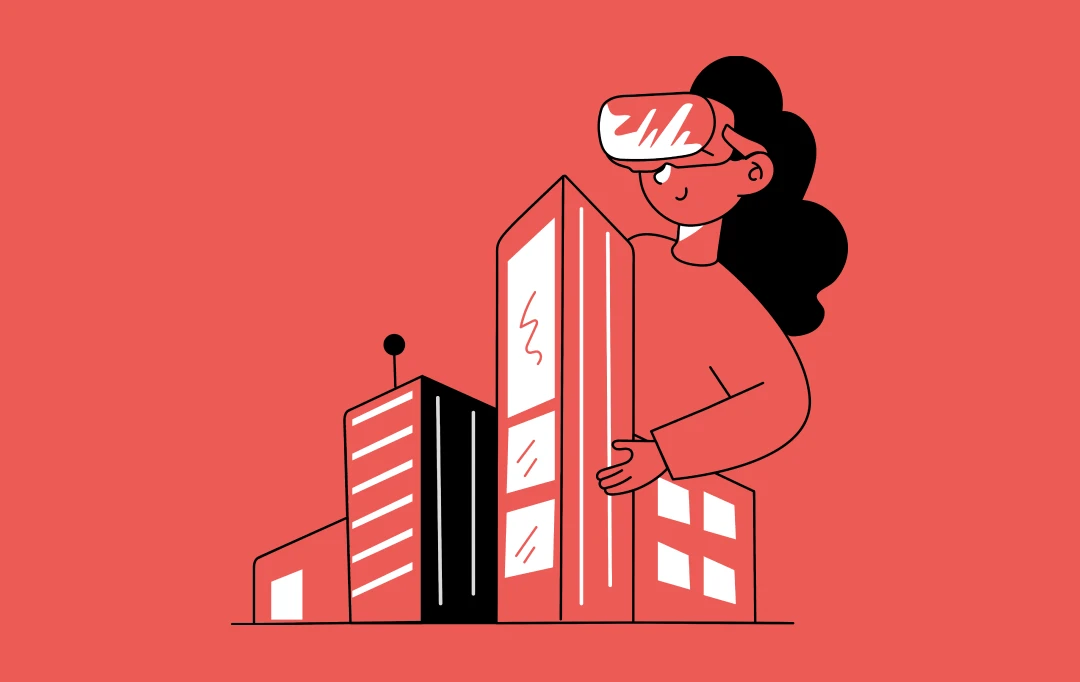- What is Spatial Computing?
- How Spatial Computing Works?
- What are the Features of Spatial Computing?
- Benefits of Spatial Computing in Enterprise
- Enhanced Visualization and Decision-Making
- Real-time Training and Skill Development
- Remote Assistance and Collaboration
- Enhanced Customer Engagement
- Data Visualization and Analytics
- Improved Safety and Training in Hazardous Environments
- Enhanced Marketing and Advertising
- Real-world Spatial Computing Examples and Use Cases
- Healthcare
- Retail
- Construction and Architecture
- Automotive Industry
- Corporate Training
- Challenges of Implementing Spatial Computing in the Enterprise
- The Future of Spatial Computing in the Enterprise
- How can Appinventiv Help?
- Conclusion
- FAQs
The fusion of the physical and virtual worlds in today’s rapidly evolving digital landscape has given rise to an exciting technological term known as Spatial Computing solutions. Enterprises are redefining their interaction with technology, unlocking a realm of possibilities and opportunities. From boosting productivity and collaboration to transforming user experiences, spatial computing in enterprise represents the forefront of digital innovation.
The spatial computing market is currently experiencing an influential surge. Projections indicate remarkable growth from 2022 to 2032. Recent statistics from Future Market Insights revealed that the market is expected to achieve an impressive Compound Annual Growth Rate (CAGR) of 18.2% during this period, surpassing the CAGR of 16.1% observed from 2017 to 2021. This exponential growth signifies the escalating demand for spatial computing solutions and highlights its transformative potential across various industries and sectors.
This article delves deep into spatial computing in the enterprise, exploring its key concepts, applications, and implications for the enterprise world. It examines how businesses can embrace this cutting-edge technology to leverage benefits and drive innovation across their operations.
What is Spatial Computing?
The term ‘spatial computing’ was introduced by Simon Greenwold, a researcher from MIT Media Lab 2003. In recent years, advancements in technology have transformed his visionary idea into a practical reality. Spatial computing technology expands beyond being just a single technology or solution; it encompasses a broader concept called extended reality (XR), which includes virtual reality (VR), augmented reality (AR), and mixed reality (MR). Ultimately, spatial computing leverages physical space as an interface for computers, liberating machines from fixed locations.
Gartner defines Virtual Reality (VR) as the creation of computer-generated 3D environments that completely immerse users and allow for natural interaction. Conversely, Augmented Reality (AR) involves real-time integration of text, graphics, audio, and virtual enhancements with objects in the real world. Combining the immersive VR experiences with the value-added visual information of AR results in spatial computing – an innovative approach to merging digital elements seamlessly into our physical surroundings.

Spatial computing represents a paradigm in which the boundaries between the digital and physical realms blur, allowing seamless interaction with digital content and data within the real-world context. This groundbreaking technology has incredible potential across various industries, promising to redefine our perception, interaction, and utilization of information and the digital landscape as a whole.
How Spatial Computing Works?
Spatial computing involves several crucial steps that effectively capture, process, and utilize spatial data. These steps enable the creation of a digital representation of the physical world, enabling various applications and generating valuable insights. The spatial computing technology process entails the following fundamental stages:
- Data acquisition: It is the initial step in spatial computing. It involves gathering spatial data from the real world through the use of various sensors, such as cameras, LiDAR, and GPS. These sensors collect information about the physical environment, enabling a comprehensive understanding of space.
- Data Processing: Data processing occurs once the collected data is ready for refinement and extraction of pertinent information. This crucial step involves various tasks, including noise filtration and merging data from diverse sources to create a comprehensive representation of the environment.
- Spatial mapping: It involves transforming acquired data into a digital model of the physical space. This process generates 2D and 3D maps while incorporating additional details like object locations and dimensions.
- Spatial analysis: This step involves utilizing processed data to gain insights and make informed decisions. By analyzing patterns, identifying trends, or predicting outcomes, businesses can effectively harness spatial computing for a wide range of applications. These applications span from urban planning to environmental monitoring.
- Spatial Visualization: It is the final step. It involves presenting the spatial data in a visually understandable format. This can be achieved by creating maps, charts, or interactive visualizations to effectively communicate the outcomes of spatial analysis.
What are the Features of Spatial Computing?
The combination of hardware and software features in spatial computing brings captivating and interactive experiences to life. This balanced blend allows for the creation of immersive digital environments that engage users in unprecedented ways. Key features driving this technology encompass various components that enable spatial computing.

- Sensor Technology: Sensor Technology plays a crucial role in spatial computing solutions. It relies on various sensors like cameras, LiDAR, and GPS to collect data from the physical environment. These sensors enable real-time tracking of position, movement, and other variables.
- Computer Vision: It enables spatial computing systems to interpret and understand visual data from the real world. This advanced technology empowers interactive experiences by facilitating the recognition and identification of objects and people, which is crucial.
- Machine Learning: Spatial computing employs machine learning, an artificial intelligence technique that allows computers to acquire knowledge from data and enhance performance progressively. This leads to improved sensor accuracy, pattern detection, and predictive analysis based on historical data.
- Augmented Reality: The seamless integration of digital information with the physical world characterizes augmented reality. By leveraging spatial computing, interactive experiences are created through AR.
- Virtual Reality: It entails the creation of entirely digital environments that enable users to interact and become fully immersed. Through the use of spatial computing, virtual reality technology can develop realistic and immersive simulations of real-world situations.
- Spatial Mapping: Spatial mapping is a process that utilizes digital representations to capture the physical environment. By analyzing space layout and object locations, spatial computing systems gain a deeper understanding of their surroundings. This understanding allows for the creation of immersive experiences.
Benefits of Spatial Computing in Enterprise
Spatial Computing brings a multitude of benefits to enterprises, completely transforming their operations and interaction with technology. Let’s explore some key benefits of spatial computing in the enterprise:
Enhanced Visualization and Decision-Making
Spatial Computing offers a remarkable advantage by providing immersive 3D visualizations, simulations, and data representations. This empowers teams to delve into profound insights, analyze intricate information, and make well-informed decisions.
To illustrate, architects can utilize spatial computing to produce interactive 3D models of buildings, enabling clients to visualize designs with the utmost clarity even before the actual construction commences.
Real-time Training and Skill Development
Real-time Training and Skill Development is one of the significant benefits of Spatial Computing. It provides realistic and interactive training experiences, particularly in high-risk industries like healthcare and aviation. In these sectors, employees can now engage in practicing complex procedures and scenarios within a safe virtual environment.
This enables them to enhance their skills and confidence level effectively. For example, surgeons can utilize Augmented Reality (AR) technology to simulate surgeries, allowing them to refine their precision before operating on actual patients.
Remote Assistance and Collaboration
Enterprises can leverage spatial computing to enhance remote support and collaboration. By utilizing Augmented Reality (AR) or Mixed Reality (MR) devices, subject matter experts can provide real-time guidance to field technicians, streamlining complex tasks while minimizing downtime and travel expenses. This application proves particularly advantageous for industries with extensive operations like telecommunications and energy.
Enhanced Customer Engagement
Spatial Computing enhances the customer experience through interactive and personalized solutions, effectively boosting customer engagement. With the help of Augmented Reality (AR), retailers can offer virtual product try-ons and visualize furniture placements in customers’ homes, enabling them to make informed decisions before purchasing. This innovative approach not only elevates engagement but also contributes to higher levels of customer satisfaction.
Data Visualization and Analytics
Spatial Computing revolutionizes data visualization and analytics. Through augmented reality (AR) and virtual reality (VR), enterprises can delve into intricate datasets, gaining profound insights in a remarkably intuitive manner. For instance, imagine data scientists examine 3D molecular models, empowering drug discovery and advancing research.
Improved Safety and Training in Hazardous Environments
Improved safety and training in hazardous environments have been revolutionized by spatial computing. Industries involved in high-risk sectors, like mining or construction, can now utilize simulated training provided by spatial computing technologies, effectively eliminating the need for exposing workers to real-life dangers. This breakthrough offers enhanced safety protocols and significantly reduces workplace accidents.
Enhanced Marketing and Advertising
Spatial Computing introduces exciting opportunities for creative marketing campaigns and interactive advertisements, enhancing companies’ marketing and advertising strategies. By leveraging augmented reality (AR), businesses can provide immersive brand experiences, captivating potential customers’ attention and leaving a lasting impact.
Real-world Spatial Computing Examples and Use Cases
Spatial computing has successfully integrated into various industries, revolutionizing their practices and delivering exceptional user experiences. Let’s explore some real-world spatial computing examples that showcase the seamless integration of spatial computing:

Healthcare
Spatial computing plays a crucial role in advancing patient care and treatment within the realm of healthcare. The COVID-19 pandemic has highlighted the urgent need for more advanced diagnostic tools.
Despite significant progress in medical technology, limited access to accurate and reliable diagnostic capabilities has hindered patient recovery. However, this critical issue is being addressed through the integration of virtual reality (VR) and augmented reality (AR) tools, combined with spatial computing technology.
Researchers at the University of Alberta have developed an innovative system called ProjectDR. This groundbreaking technology allows medical professionals to project and visualize medical images, such as CT scans and MRI data, directly onto the patient’s body in real-time. By utilizing spatial computing platform, the system presents dynamic and interactive visualizations synchronize with the patient’s movements.
The system incorporates a motion-tracking mechanism, utilizing infrared cameras and markers placed on the patient’s body to precisely display segmented images of specific organs as required by clinicians. This targeted examination approach enables precise and focused analysis for medical practitioners.
Retail
In the world of retail, IKEA Place has established itself as a pioneering augmented reality app that revolutionizes the furniture and home decor shopping experience. By utilizing spatial computing technology, this innovative app allows customers to embark on a virtual interior design journey without leaving their homes.
The application opens up a world of endless possibilities, enabling users to virtually position a vast range of IKEA furniture and home decor items within their living spaces. The entire IKEA catalog transforms into a digital haven of design inspiration, from sofas and tables to lamps and rugs.
By utilizing their smartphones or tablets’ cameras, users can scan their surroundings and witness them transform into interactive canvases for interior experimentation. With ease, they can position furniture pieces exactly where they envision them and effortlessly explore different configurations.
Construction and Architecture
Microsoft’s HoloLens mixed reality headset has revolutionized the construction and architecture industry, serving as a transformative tool. Through its groundbreaking spatial computing capabilities, HoloLens empowers contractors and architects to breathe life into building designs, allowing for immersive interactions with dynamic 3D models.
Professionals can seamlessly integrate virtual structures into the real world through the use of the HoloLens headset. This immersive experience empowers them to make well-informed decisions about design elements and placements directly on-site, enhancing planning, coordination, and problem-solving capabilities. By viewing designs in their proper context, professionals achieve greater efficiency throughout the construction process.
The integration of HoloLens in the construction industry signifies a remarkable advancement, revolutionizing the entire process of building design and visualization. This spatial computing technology for businesses propels the future of construction and architecture even further, promising unprecedented levels of creativity, efficiency, and innovation.
Automotive Industry
In the automotive industry, spatial computing is emerging as a powerful solution for addressing the challenges of 3D-design. Leading companies like Ford are leveraging innovative tools such as Gravity Sketch. These tools harness the capabilities of augmented reality and spatial computing to craft 3D models of automobiles intricately.
With spatial computing as its foundation, this technology enables automotive designers to move beyond the limitations of traditional 2D design. By immersing themselves in a virtual world, they can manipulate and shape digital objects with the same ease as physical creations. This innovative process facilitates a more intuitive and intricate approach to automotive design, fundamentally transforming the creative journey.
Corporate Training
Spatial computing technology holds immense potential for corporate training, especially in industries like energy. Here, workers can greatly benefit from immersive learning experiences. By utilizing computer-generated 3D environments that replicate actual workplaces and scenarios, employees can undergo training that closely mimics their real work settings. This not only enhances skill development but also boosts problem-solving capabilities.
In office environments, spatial computing has the potential to transform communication and collaboration completely. By blending video streams and leveraging augmented reality, virtual meetings with employees and stakeholders can be exponentially enhanced in terms of effectiveness.
This immersive technology enables individuals from diverse geographical locations to seamlessly communicate and share vital information, ultimately fostering a stronger sense of global connectivity and facilitating collaborative efforts.
General Electric (GE) serves as an excellent illustration of the spatial computing impact on enterprise. Here, technicians were equipped with AR glasses, leading to a staggering 34% increase in productivity per worker. By providing an immersive method for accessing vital information during work, these AR glasses greatly enhanced efficiency and overall performance among technicians.
Challenges of Implementing Spatial Computing in the Enterprise
Implementing spatial computing in the enterprise poses challenges. These challenges must be addressed for successful enterprise adoption of spatial computing and integration. While this technology offers numerous benefits, it is essential to acknowledge and overcome these obstacles. Some of the key challenges include:
- Cost: The cost of integrating spatial computing technologies in the enterprise can pose a significant financial challenge, particularly for smaller businesses or those operating on limited budgets. Expenses related to hardware, software, and training can serve as substantial entry barriers for enterprises in this domain.
- Data Privacy and Security: In spatial computing, sensitive data regarding physical environments and users is often collected and processed. To prevent unauthorized access or misuse of this information, ensuring data privacy and security becomes paramount.
- Compatibility and Integration: Many enterprises already have established systems and workflows in place. To seamlessly integrate spatial computing with these existing structures, careful planning is necessary to prevent disruptions.
- Bandwidth and Connectivity: Some spatial computing applications rely on strong internet connectivity and high bandwidth for optimal functioning. However, in areas where internet infrastructure is limited, this can pose a challenge to the seamless operation of spatial computing solutions.
- Interoperability: Regulatory compliance adds complexity to the implementation of spatial computing technologies in the enterprise, as enterprises must adhere to specific regulations and standards based on their industry and location.
The Future of Spatial Computing in the Enterprise
The future of spatial computing and digital transformation in the enterprise holds tremendous potential for driving transformation and innovation. As technology advances, businesses can expect a paradigm shift facilitated by spatial computing.
This new approach will revolutionize operations and interactions with the digital landscape, showing in enhanced productivity as well as seamless collaboration through real-time data access. Additionally, decision-making and problem-solving processes stand to benefit from accelerated timelines with spatial computing’s ability to provide instant insights.
Furthermore, employees will experience immersive and interactive training and learning experiences, empowering them through hands-on simulations and skill development programs. The data visualization and analytics are also set to reach unparalleled heights, offering deeper insights that facilitate informed decision-making across various domains.
How can Appinventiv Help?
Appinventiv, a prominent AR/VR development company, can be your trusted partner in unlocking augmented and virtual reality’s full potential for your business. Our expertise lies in crafting highly immersive experiences that captivate users and yield exceptional outcomes. Let us demonstrate how we can assist you:
- Immersive Experiences: Our team specializes in crafting augmented and virtual reality solutions. These cutting-edge technologies transport users to captivating virtual environments, elevating engagement levels while leaving a lasting impression.
- Tailored Solutions: Our team collaborates closely with clients to fully grasp their distinctive business needs and objectives. Subsequently, we craft bespoke AR/VR solutions that seamlessly align with their vision while catering precisely to their intended audience.
- Cutting-Edge Technology: We utilize the most advanced tools and technologies to create groundbreaking AR/VR experiences that lead the industry. This ensures that your business stays ahead of the curve, constantly pushing boundaries with innovative solutions.
- Agile Development: By adopting an agile and user-centric approach, we ensure the prompt and efficient delivery of results. We value regular feedback and iterations to enhance experiences to their utmost perfection.
Conclusion
Spatial computing technology for businesses is revolutionizing the way companies interact with technology, providing immersive experiences and boosting productivity. At its core, spatial computing integrates AR, VR, and MR to bridge the gap between physical and digital realms. This rapidly expanding market holds immense transformative potential across various industries. To unlock the full potential of spatial computing, Appinventiv, with its bespoke AR app development services, offers tailored solutions and cutting-edge technology to businesses. Embrace this digital frontier and flourish amidst a new wave of innovation.
FAQs
Q. What is an example of spatial computing?
A. As discussed earlier, IKEA Place, an AR app, serves as a prime example of spatial computing in business. It empowers users to virtually position furniture within their living spaces before making a purchase. By seamlessly merging the digital and physical realms, this innovative app offers a captivating experience for potential buyers.
Q. What is spatial computing mainly used for?
A. Enterprise spatial computing solutions find their main application in the creation of immersive experiences. These experiences include augmented and virtual reality applications, interactive simulations, and data visualization within real-world environments.
Q. How does spatial computing enhance safety in hazardous environments?
A. Spatial computing in enterprise enables the development of immersive virtual simulations in high-risk industries such as construction and mining. These simulations effectively train workers while minimizing their exposure to real-life hazards, thus enhancing safety protocols.


- In just 2 mins you will get a response
- Your idea is 100% protected by our Non Disclosure Agreement.

10 Use Cases and Examples of How Extended Reality (XR) is Driving Innovation Across Industries
Imagine a factory where engineers diagnose machinery issues using 3D holograms or a hospital where surgeons rehearse complex procedures in a fully immersive virtual space before operating on a real patient. These scenarios are not distant possibilities - they are happening today and are powered by Extended Reality - XR use cases. As a convergence…

13 Use Cases and Examples of How Adaptive AI is Transforming Industries
Slashing downtime, boosting margins, automating workflow, and stealing your market share. You must be thinking that these buzzwords are Silicon Valley’s hype. No, these are the silent revolutions hitting Main Street industries. From manufacturing deploying demand forecasting to controlling production lines, healthcare tailoring predictive care and driving better outcomes. The success mantra—these industries are quietly…

AR/VR in Construction - 10 Use Cases of How Augmented and Virtual Reality is Shaping the Industry
The use of extended reality technologies is one of the growing trends in the expanding domain of construction technology. As the sector gradually adopts more sophisticated practices, virtual and augmented reality in construction have emerged as revolutionary solutions. With compelling advantages like planning, marketing, and training, AR/VR technologies are transforming the face of construction. Prescient…

















